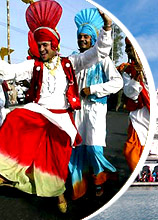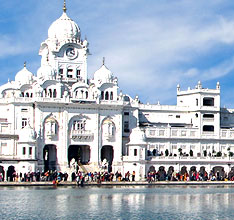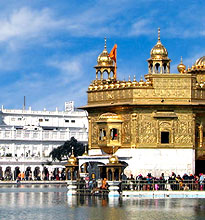 Patiala is the erstwhile princely state of Punjab, which is situated in the Malwa region. It is surrounded by Fatehgarh Sahib, Rupnagar and Chandigarh in the north, Sangrur district in the west, Ambala and Kurukshetra in the east and Kaithal district in the South. The city covers a total area of 3625 sq km. It is a judicious synthesis of a brilliant spectrum of Rajput, Mughal and Punjabi cultures and a fine blend of modernity and tradition. It was Maharaja Bhupinder Singh (1900-1930) who gave Patiala state a prominent place in the political map of India. Though historians have tried to trace the origin of Patiala to Rig Vedic literature, the town, as it stands today, was founded by Baba Ala Singh. It was founded with the construction of Qila Mubarak in 1763.
Patiala is the erstwhile princely state of Punjab, which is situated in the Malwa region. It is surrounded by Fatehgarh Sahib, Rupnagar and Chandigarh in the north, Sangrur district in the west, Ambala and Kurukshetra in the east and Kaithal district in the South. The city covers a total area of 3625 sq km. It is a judicious synthesis of a brilliant spectrum of Rajput, Mughal and Punjabi cultures and a fine blend of modernity and tradition. It was Maharaja Bhupinder Singh (1900-1930) who gave Patiala state a prominent place in the political map of India. Though historians have tried to trace the origin of Patiala to Rig Vedic literature, the town, as it stands today, was founded by Baba Ala Singh. It was founded with the construction of Qila Mubarak in 1763.Administratively, Patiala district can be sub-divided into 5 tehsils, 3 sub-tehsils and 8 blocks. It forms a part of the Indo-Gangetic plain and consists of three types of region-The Upland Plain, The Cho-Infested Foothill Plain and the Flood plain of the Ghaggar River. There is a complex drainage system running through the district, consisting of canals and rivers. The river Ghaggar is the most important water channel of the district. Apart from the natural drainage line, the district also has three important canals - the Bhakra Main Line Canal, the Nawana Branch and the Ghaggar Link. These canals provide the much needed irrigation water to the district.
Patiala, the administrative headquarters of Patiala District, is the first city in Punjab to have the Degree College - Mohindra College, in 1870. It has a distinct culture of its own, known as the "patialvi” culture. Though many traits are borrowed from the Rajput style, its beauty and elegance have been, however, molded according to the local coloring. With the active patronage of the erstwhile rulers of Patiala, a well established style of Hindustani music, called the "Patila Gharana”, came into existence. At the turn of the century, Ustad Ali Bux was the most renowned exponent of the Gharana. Later, his sons, Ustad Akhtar Hussain Khan and Ustad Bade Ghulam Khan achieved world-wide fame in the Patiala Gharana.
Patiala has a rich gallery of architecture. which is well represented in the various tourist attractions. such as Qila Mubarak, Qila Androon, Darbar Hall, Lassi Khana, Ran-Bass, Moti Bagh Palace, Sheesh Mahal, Lachman jhoola, Baradari Gardens and Goddess Kali Temple. The city is famous for its turban (traditional headgear), paranda (tasseled tag for braiding hair), peg (a measurement of wine), jutti (traditional Punjabi footwear) and "Patiala” salwar. Agriculture forms the main source of income for the people. With 65% of the population living in rural areas, 385 of the population depend on agriculture, either as laborers or cultivators. Patiala is rapidly growing as the industrial sector of Punjab, producing both the traditional and the highly sophisticated modern items.
Bahadurgah Fort
Bahadurgah Fort is a famous tourist attraction of Punjab, located 6 km away from the city of Patiala. It lies at a distance of one and half kilometer from the main gate of Punjab University. The fort was built in 1658, by Nawab Saif Khan and was called Saifabad.
How to Reach Patiala
Patiala is one of the erstwhile princely cities of Punjab. It has a well-developed infrastructure, which connects the place with different parts of the country. Though it has no air and rail service of its own, the services are available at close proximity.
Qila Mubarak
Qila Mubarak is one of the prominent tourist attractions of Patiala. Built in 1764, by Maharaja Ala Singh, the fort was originally made as a mud fort or kachi garhi. The Maharaja constructed the pacca qila after his conquest of Sirhind. He constructed the qila by using the octroi received from the merchandise passing through his territory of the GT road. Qila Mubarak stands in a 10-acre ground, in the heart of the district, about 29 km to the west of Ambala.
Sheesh Mahal
Sheesh Mahal, or the Palace of Mirrors, is one of the popular tourist attractions of Patiala. It flaunts the ostentatious grandeur of the royal Maharajas. The palace has been named so, owing to its exquisite interior that is completely ornate with mirrors and glasses, along with the pretty floral motifs painted on the walls. There are grand mural paintings therein, most of which portray themes from mythology and religion.
Tourist Attractions in Patiala
Patiala district is one of the famous princely states of erstwhile Punjab, with the administrative headquarters bearing the same name. It is rich with attractions that invite tourists throughout the year. The place has historical monuments, which speak of a rich tradition and legacy.
Patiala Weather
Patiala, like any other place in Punjab, experiences extreme summer and winter season. The weather of the district can be mainly classified as tropical steppe, semi-arid and hot. Patiala is dry mostly throughout the year, except for the monsoon season, when it receives heavy downpours.











